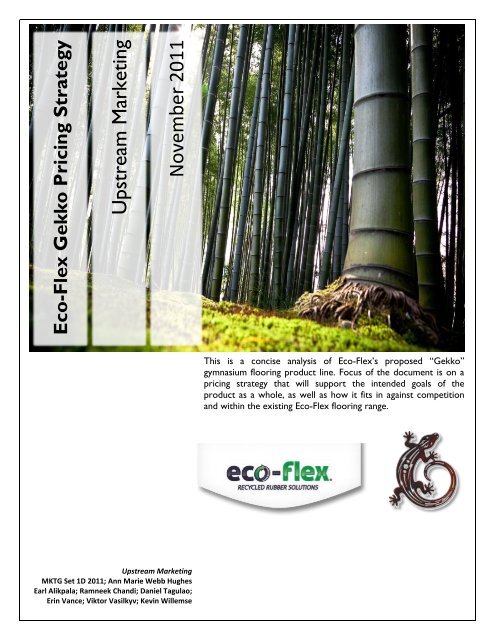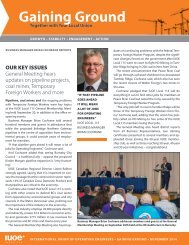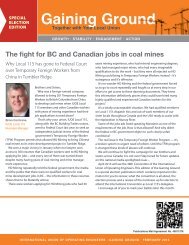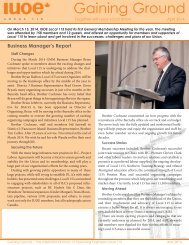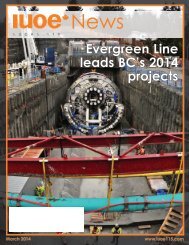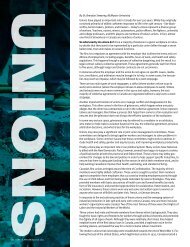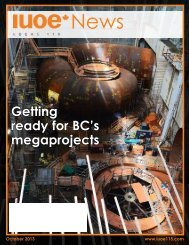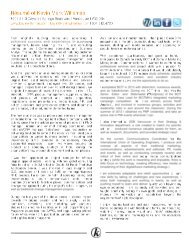Upstream Marketing November 2011
You also want an ePaper? Increase the reach of your titles
YUMPU automatically turns print PDFs into web optimized ePapers that Google loves.
Eco-Flex Gekko Pricing Strategy<br />
<strong>Upstream</strong> <strong>Marketing</strong><br />
<strong>Upstream</strong> <strong>Marketing</strong><br />
MKTG Set 1D <strong>2011</strong>; Ann Marie Webb Hughes<br />
Earl Alikpala; Ramneek Chandi; Daniel Tagulao;<br />
Erin Vance; Viktor Vasilkyv; Kevin Willemse<br />
<strong>November</strong> <strong>2011</strong><br />
This is a concise analysis of Eco-Flex’s proposed “Gekko”<br />
gymnasium flooring product line. Focus of the document is on a<br />
pricing strategy that will support the intended goals of the<br />
product as a whole, as well as how it fits in against competition<br />
and within the existing Eco-Flex flooring range.
CONTENTS<br />
Objective ......................................................................................................................................................................... 2<br />
Problem Statement (Goal) .............................................................................................................................................. 2<br />
Key Findings .................................................................................................................................................................... 2<br />
SWOT Analysis ................................................................................................................................................................. 2<br />
Competitive Analysis ....................................................................................................................................................... 3<br />
Target Market ................................................................................................................................................................. 5<br />
Behavioural ................................................................................................................................................................. 5<br />
Demographic ............................................................................................................................................................... 5<br />
Geographic .................................................................................................................................................................. 5<br />
Potential Market Segments......................................................................................................................................... 6<br />
Alternatives ..................................................................................................................................................................... 6<br />
Penetration Pricing ...................................................................................................................................................... 6<br />
Advantages .............................................................................................................................................................. 6<br />
Disadvantages ......................................................................................................................................................... 6<br />
Target Profit Pricing .................................................................................................................................................... 7<br />
Advantages .............................................................................................................................................................. 7<br />
Disadvantages ......................................................................................................................................................... 7<br />
Yield Management Pricing with Quantity Discounts .................................................................................................. 7<br />
Advantages .............................................................................................................................................................. 7<br />
Disadvantages ......................................................................................................................................................... 7<br />
Solution ........................................................................................................................................................................... 8<br />
Implementation .............................................................................................................................................................. 8<br />
Price ............................................................................................................................................................................. 8<br />
Product ........................................................................................................................................................................ 8<br />
Promotion ................................................................................................................................................................... 9<br />
Place ............................................................................................................................................................................ 9<br />
Conclusion ....................................................................................................................................................................... 9<br />
1 | P a g e
OBJECTIVE<br />
The objective of this report is to analyze the current positioning of Eco-Flex and provide various pricing strategies<br />
for the introduction of their new gymnasium flooring product, codenamed “Gekko”.<br />
PROBLEM STATEMENT (GOAL)<br />
What pricing strategy (supported by an appropriate market strategy) should Eco-Flex use Gekko, to generate a<br />
minimum of $300,000.00 profit in its first year in the market, sell at least 10,000m 2 of product, and capturing a 12%<br />
market spend share during its first year?<br />
KEY FINDINGS<br />
Eco-Flex, an Alberta, Canadian manufacturer of rubber based products derived from recycled rubber tires, has<br />
proposed the feasible development of a new product code-named, “Gekko”, based on a Request for Proposal as<br />
well as analysis of potential markets.<br />
This new product combines a rubber techno-material with a bamboo backing to produce a flooring piece. Bamboo<br />
flooring products are increasing in North America as they are more dimensionally stable compared to red oak<br />
flooring and laboratory-made laminated bamboo lumber (Lee & Liu, 2003). In addition, bamboo-based flooring is<br />
more environmentally sustainable because it can be harvested earlier i.e. - within 5 years as compared to decades<br />
for hardwood trees (Kaiser, 2004) . If the product is manufactured under the proper guidelines, it can obtain LEED<br />
certification, the international standard for green building designs, as per the bulk of Eco-Flex’s other product lines.<br />
Increased corporate sustainability practices have been placed in the spotlight in the past few years, as 93% of CEOs<br />
surveyed recognize this need for the future success of their companies (Singh, <strong>2011</strong>) Eco-Flex’s Gekko flooring is<br />
the first of its kind and can tap into the growing market for sustainable business products and practices.<br />
Gekko’s cost of production is composed of a variable cost of $18.97/m 2 and monthly fixed costs of $8,799/month<br />
(Refer Appendix: Table of Fixed & Variable Costs vs. Profit). Sophie’s conservative estimate sales forecast for<br />
Gekko is 500m 2 , requiring a retail price of $36.57/m 2 to break-even. If the quantity demanded for Gekko reaches<br />
Eco-Flex’s production capacity of 2000/m 2 , a retail price of $23.37/m 2 is needed to reach the break-even point.<br />
With a predicted demand of 500m 2 , the calculated manufacturing break-even price is $36.58m 2 (Refer to Appendix<br />
“Table 1: Break Even Analysis”).<br />
Taking into consideration all calculations of Eco-Flex’s production capacities with price of $45.00, the estimated<br />
break-even volume is 338 units.<br />
SWOT ANALYSIS<br />
Eco-Flex is in a very niche product market, and as such careful attention must be paid to the changing landscape it<br />
offers. It must constantly be aware of its own strengths and leverage these to counter weaknesses. The current<br />
social climate favours innovative, sustainable companies such as Eco-Flex which presents massive opportunity, but<br />
growing competition and keeping up with new innovations, all while balancing costs and consumer demand, is not<br />
to be taken lightly.<br />
2 | P a g e
Strengths Weaknesses<br />
Existing rubber flooring product R&D, manufacturing &<br />
marketing expertise<br />
Established dealer network<br />
Broad existing customer base as potential new product<br />
market<br />
Growing brand & product awareness (Vancouver<br />
games, media coverage)<br />
LEED Accreditation<br />
Healthy holding company turnover with various product<br />
lines and markets<br />
Opportunities Threats<br />
Growing favour towards eco-aware products and<br />
companies in all organizational markets (esp.<br />
B.C./Canada)<br />
Growing awareness of recycled-rubber-based industrial<br />
products<br />
No existing similar product<br />
Product visibility (esp. in large public installations) easily<br />
creates interest<br />
Low production capacity<br />
Limited experience in composite (dual core) product<br />
development<br />
No patents or unique/specialty products make them<br />
open to competitor attack and imitation products<br />
Poor brand awareness, disjointed campaign (through<br />
resellers)<br />
Reddening competition ocean<br />
Imitation (inferior or improved) product emergence<br />
Long term product performance still to be evaluated<br />
Raw material costs may rise with elevated demand (tires<br />
and bamboo)<br />
From the above, it is noted that Eco-Flex is presented with many opportunities, and each one of these must be<br />
investigated to maximise profits. Balancing these against threats highlights the fact that in order to capitalise on<br />
these opportunities, while eradicating weaknesses, will require a conscious, well thought-out and swift strategy to<br />
protect itself from competition and subsequent losses. This must also be applied to the Gekko product, to ensure<br />
its success and grow Eco-Flex’s overall market share.<br />
COMPETITIVE ANALYSIS<br />
When comparing Eco-Flex to its notable competitors, there are many similarities in terms of market and product,<br />
with the notable exception of a wood-faced gymnasium product such as Gekko. These competitors therefore have<br />
the ability to not only compete with Eco-Flex’s current products, but also to create a product that can be<br />
comparable to Gekko. Legal/patent considerations aside, this is a critical element that Eco-Flex must consider<br />
should they move forward with Gekko production and its associated market launch.<br />
Another important factor is that Eco-Flex uses a dealer and reseller network to resale and install product – these<br />
resellers have a diverse, non-exclusive bouquet of products which actually compete with Eco-Flex’s products. While<br />
this is a normal, accepted practice, Eco-Flex and Gekko must compete within this scenario. It also makes<br />
competitive analysis (in terms of manufacturing competition vs. product competition) difficult to easily assess.<br />
3 | P a g e
Eco-Flex 1<br />
1.) Ecoflex Safety Flooring<br />
2, 3<br />
(India)<br />
4, 5<br />
2.) RB Rubber Products<br />
6, 7, 8<br />
3.) Ecore International<br />
4.) Zebra Mats (Canada) 9<br />
Average Years Location Produced Approx. Product<br />
Range<br />
Approx. Tires<br />
Recycled P/A<br />
Over 30 years Near Edmonton, Alberta 25 12 million tires P/A.<br />
Over 50 years<br />
(1960)<br />
Over 25 years<br />
(1985)<br />
Over 40 years<br />
(1989)<br />
Over 10 years<br />
(1997)<br />
Mumbai, India Under 10 6 million tires P/A.<br />
McMinnville, OR Over 30 Over a millions<br />
pounds P/A<br />
Lancaster, Pennsylvania 16 4 million tires P/A<br />
Toronto, Ontario Over 30 Not Available<br />
References: 1. (Graphos, <strong>2011</strong>); 2. (EcoFlex); 3. (Ride4ever, 2010); 4. (Incorporated, <strong>2011</strong>); 5. (Consulting); 6. (Flooring, <strong>2011</strong>); 7. (Businessweek); 8.<br />
(International, Sport and Recreation Surfacing); 9. (Canada Z. M., 2009)<br />
While the above chart looks at rubber flooring manufacturers, it is clear that Gekko will compete against producers<br />
and installers of “traditional” wooden gymnasium flooring. These are usually solid wood or parquet installations<br />
installed only in higher-end sports facilities due to high price and maintenance costs, and not in free-weight areas<br />
or harsh environments due to their weaker surface properties. However they offer the lateral and vertical flex<br />
required by gymnasium sports persons (dancers, basketball, gymnastics etc.)<br />
With this in mind, Eco-flex’s Gekko will have several advantages over its competitors (standard wood flooring<br />
products):<br />
Improved life span (15 years before replacement or refurbishing vs. 3-5 years on wooden floors)<br />
Bamboo backing with rubber substrate is unique, combines attractive design with durability and comfort<br />
Has a competitive advantage thanks to Eco-Flex’s large existing client base<br />
Is inexpensive and easy to install, even by home users (end consumers) and replace panels<br />
The chart below exhibits indicative pricing in regards to vinyl, synthetic, and wood flooring. Eco-Flex is competing to<br />
replace wood flooring in places such as gyms and the chart below demonstrates how much it currently costs and<br />
how long the flooring is expected to last.<br />
The inserted chart is indicative pricing of a large competitor, a<br />
producer and installer of wooden gymnasium/sporting flooring<br />
(GROUP, 1997). The above chart shows how a 465m 2 floor has<br />
an initial outlay cost of $65,000.00, and is quoted as lasting up<br />
to 50 years. However, one must remember that this floor wood<br />
require stripping, sanding, repainting and refinishing every 3<br />
years at a cost of approximately $8,000.00 (GROUP, 1997). If we<br />
extrapolate this into a comparative cost against Gekko’s 15 year<br />
life span, the total cost of ownership would be approximately<br />
$105,000.00. This further equates to a price of approximately<br />
$225.00 per square metre of wooden flooring.<br />
4 | P a g e
As one can see, this is a very high price for a premium floor, and Gekko is far more competitive and should perform<br />
as well with less downtime due to maintenance. It is also a more sustainable product, not only upon installation,<br />
but also no harsh chemicals or resins etc. are required for refinishing and repair.<br />
TARGET MARKET<br />
BEHAVIOURAL<br />
Eco-Flex’s product offers quality and a low price compared to other flooring. It benefits business consumers who<br />
are looking for eco-friendly products, primarily for indoor sporting facilities, but may even include outdoor flooring<br />
applications. Eco-Flex, an ecologically aware manufacturer, has the opportunity to target the “green market”<br />
movement, to further cater towards their existing loyal client base.<br />
DEMOGRAPHIC<br />
Demonstrating the product and its uniqueness to sporting facilities, real estate developers and large private<br />
installations will help Eco-flex build up an initial sales volume. Sporting facilities (e.g. North American fitness chain<br />
GoodLife) has 123 gyms across Canada; of the 123 gyms, 11 of them are franchised (Magnan, 2007), which<br />
demonstrates an opportunity to sell the product into franchise chains and increase volumes. The exposure that<br />
public gymnasiums create for private consumers as well as potential business decision makers can create a<br />
potential relationship and revenue stream for Eco-Flex.<br />
We also investigated approaching Real Estate developers and having them promote Gekko flooring over other<br />
alternatives, and even targeting government; with their 15,500 elementary schools, 163 private and public<br />
universities, and 183 public colleges and institutions, the amount of gymnasium and sporting facilities they install<br />
and maintain is lucrative. (The Council of Ministers of Education, <strong>2011</strong>).<br />
Eco-Flex has established itself (including Gekko and most of its rubber mats) in the NAICS category 44221 (floor<br />
covering stores) (Canada I. , <strong>2011</strong>); resellers and buyers the company conducts business with will be in the same<br />
NAICS category.<br />
GEOGRAPHIC<br />
There is a growing trend in North America for entire cities to become more environmentally friendly. Proposed<br />
green city capitals, such as San Francisco, Vancouver, New York, Seattle, and Denver (SIEMENS, <strong>2011</strong>) will be ideal<br />
urban areas for Gekko’s distribution and segmentation. By targeting these cities with an overall green standard<br />
performance of 73% and greater, Gekko can further improve their environmentally friendly credentials.<br />
5 | P a g e
POTENTIAL MARKET SEGMENTS<br />
In terms of actually labelling potential markets, Gekko could segment and target the following:<br />
Sporting Facilities<br />
The core market for Gekko – not only can Eco-Flex actively approach sports facilities and gymnasiums,<br />
dance studios and the like, they can leverage off existing Government projects (e.g. sidewalk and<br />
Vancouver 2010 project) to propose installations in public school sports facilities. Franchise gymnasiums<br />
and fitness clubs can also be approached for large-scale, volume-discounted long term supply and install<br />
partnerships and contracts.<br />
Commercial / residential Building Developers<br />
Gekko’s attractive appearance, low cost, insulating properties, comfortable feel and durable nature makes<br />
it a potential fit for developers looking for premium flooring for both offices and high rise apartments. The<br />
noise dampening characteristics and soft touch of Gekko will appeal to executive suite buyers, and the<br />
fireproof, sustainable credentials make it even more appealing<br />
Direct to Consumer<br />
Gekko’s easy-to-install nature makes it a potential candidate for selling directly to consumers for home<br />
installation, or by appointed contractors (using channels such as Home Depot, Roma etc.). Many affluent<br />
Canadians and Americans install home gymnasiums that must be attractive, removable and durable, and<br />
Gekko meets these demands.<br />
ALTERNATIVES<br />
PENETRATION PRICING<br />
With this strategy, the company can expect to receive profits of $208,000 within Gekko’s first year, and $461,000 in<br />
second year, based on a continuing volume growth rate. This strategy allows the company an increase in<br />
production capacity and creates a stable cash flow. As we are looking for rapid penetration, we are adopting a low<br />
profit margin which still supports a profitable model. It also carries the various flexibility and scaling models as<br />
discussed in this document.<br />
Our penetration entry price is proposed at $40.50<br />
ADVANTAGES<br />
Rapidly captures a new market, which is important to thwart competitor entry<br />
Price of $40.50 delivers profit, even with predictable demand of 500m 2 , which will likely be far surpassed<br />
Allows for scaling of prices as market, demand and exclusivity grows, to further increase profits.<br />
DISADVANTAGES<br />
Long term profit orientation (Will not achieve profits when just launched, requires fair volume)<br />
Cannot rapidly maximize profits by changing the price (move from Penetration to Prestige is limited)<br />
Rapid demand beyond current capacity will require major production, operations and management<br />
overhaul to meet these<br />
6 | P a g e
TARGET PROFIT PRICING<br />
This pricing strategy provides a specific annual target of a specific dollar volume of profit.<br />
The proposed Target Profit Price is $65.00<br />
ADVANTAGES<br />
Stable profit markup margin of 77% (based on minimum 500m 2 )<br />
This model still delivers a $270,000 profit within the first year, based on the minimum projected order<br />
quantities<br />
Same price for all customers makes managing sales, profits and projections/analysis simple<br />
DISADVANTAGES<br />
Inflexible model – adjustments can have major effect on targets<br />
The higher markup will make the market attractive to competitors<br />
Hard to manage/create the demand based on specific market value perceptions<br />
No rapid growth; market penetration could be slower<br />
Refer to Appendix 3: Profit Target Pricing Chart for a full breakdown of how this strategy demonstrates its various<br />
advantages and disadvantages.<br />
YIELD MANAGEMENT PRICING WITH QUANTITY DISCOUNTS<br />
This alternative could be used in combination with the first two alternatives (it is suggested that Eco-Flex<br />
investigate a homogenous approach towards their product pricing overall). This option strategically prices the<br />
Gekko product depending on the quantity demanded and supplied. To ensure a greater quantity purchased by<br />
buyers, a quantity discount is coupled with the yield management pricing strategy.<br />
ADVANTAGES<br />
Persuades clients to buy more, thus meeting Gekko’s main aim of increasing quantity<br />
Large dollar amount profit margin calculated into each price break<br />
Control of production is much more regulated<br />
DISADVANTAGES<br />
Eliminates small quantity buyers<br />
Complex model of quantity/price<br />
Hard to generate demand due to different pricing models<br />
Refer to Appendix 4: Table 4: Yield Management Pricing Chart for a full breakdown of anticipated volumes and<br />
pricing related to this model.<br />
7 | P a g e
SOLUTION<br />
The alternative that will be the most beneficial for the introduction of the Gekko product is penetration pricing.<br />
This option will allow Eco-Flex to introduce their product at a low price while supporting the need to rapidly grow<br />
market share (before competition products enter; processed Bamboo flooring products are rapidly being<br />
developed and released to the market (Lee & Liu, 2003)) as well as the need to maximise volumes to meet the<br />
target profit. The sales they will produce from the low cost appeal will give them a chance to gain a positive<br />
reputation and large customer base for their product.<br />
Once demand increases, Eco-Flex will then be able to subtly raise Gekko prices, thanks to a large existing customer<br />
base and proven product. Furthermore, this adds to the exponential profits created by covering fixed costs.<br />
By offering the product at a very low profit margin, Gekko has the greatest chance of capturing the 12%<br />
market share Eco-Flex are aiming for, and still meet the overall profit targets<br />
The company’s research shows that conservative demand estimates support these targets, boosted by the<br />
penetration strategy which should further increase the ability to meet set goals<br />
Based on these projections and annual achievable sales using the penetration strategy, Eco-Flex should<br />
achieve these targets by the end of its first year of selling Gekko.<br />
If penetration pricing is not chosen by Eco-Flex, our second choice would be target for profit pricing. This would<br />
allow for full consistency in the price given to customers, and would launch the product with an opportunity to gain<br />
workable profit margins. Eco-Flex should investigate an integrated model of pricing strategies as well (i.e.,<br />
combining all strategies to maximise market yield).<br />
IMPLEMENTATION<br />
The pricing strategy of Gekko is critical to its success; however it must be bolstered by a comprehensive marketing<br />
strategy which supports the chosen pricing models. This must encompass how we will leverage the pricing model<br />
into the market, where, and how it will be presented to the market as a whole.<br />
PRICE<br />
The price of $40.50 is an excellent entry point as a vehicle for initial market launch and rapid penetration, which<br />
should guarantee profits even given a low anticipated initial demand. The lower price point breaks down potential<br />
entry barriers and accomplishes our main aim of rapidly growing and protecting a new market share during its first<br />
year. Considering buyer retention and loyalty on products such as Gekko is high, getting that initial share is critical,<br />
and the chosen price must support achieving this. As market share is established, Eco-Flex could leverage this<br />
market share during its second (and future) years by slowly raising prices and further growing volumes.<br />
PRODUCT<br />
The Gekko product will have many unique properties and a definite market position. It is worthy of a strategy that<br />
ensures the product is a success. It fits in well with Eco-Flex’s range (and ecological statement) and can utilise the<br />
company’s existing sales and manufacturing abilities and reseller/customer networks.<br />
8 | P a g e
PROMOTION<br />
Since Eco-Flex depends on its resellers and distributors to promote and sell its products, an intense reseller<br />
education program must be implemented. This will be focussed initially on larger volume resellers who have<br />
established partnerships and large strategic customer relationships.<br />
This will mean the Eco-Flex sales force will immediately start setting up meetings with these contractors and<br />
partners, to provide promotional materials, samples and interactive training as to how best market the product to<br />
potential buyers. Furthermore, Eco-Flex will have to educate the contractors regarding installation procedures. Eco-<br />
Flex’s sales team can also approach actual business buying organizations for bulk purchase opportunities (e.g. long<br />
term government contracts or franchise sporting complexes). Eco-Flex must aggressively promote Gekko at trade<br />
shows, expos, trade magazines and on their website.<br />
These promotional campaigns must be prepared and launched at the same time Gekko first rolls off the production<br />
line.<br />
PLACE<br />
Eco-Flex has representation and resellers across Canada and North America, which are used to bring the current<br />
range of products to market. For Gekko, Eco-Flex will utilise these same channels. If demand grows sufficiently,<br />
Eco-Flex can expand Gekko’s geographic visibility by approaching the over 10,000 flooring stores and contractors<br />
(Co, 2009) to broaden their distribution channels further into both regions, and even look at global exports through<br />
overseas partnerships.<br />
CONCLUSION<br />
Eco-Flex has an excellent opportunity to enter the marketplace with an innovative flooring concept that can<br />
compete well against existing markets as a unique, eco-friendly product.<br />
As demonstrated in this document, volume and rapid presentation must be attained to ensure Gekko captures the<br />
market share and ongoing profits as defined in our overall goal.<br />
9 | P a g e


